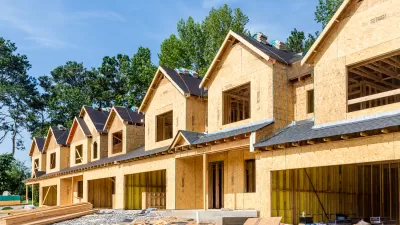As the state modernizes its infrastructure, concerns of continued coastal erosion and future sea-level rise raise questions of where to place key infrastructure.
As the Golden State's cities look to modernize and upgrade their aging infrastructure, agencies like the California Coastal Commission are pressuring municipalities to relocate key facilities inland. "Charles Lester, executive director of the Coastal Commission, said the agency is pushing towns to move infrastructure inland where practicable, out of concerns including erosion and the effect of rising sea levels due to climate change," reports the Wall Street Journal's Jim Carlton.
But many cities, already scrapped for cash, are worried about the substantial increase in cost and time that moving the infrastructure will entail. One example is a plan to rebuild a 60-year-old sewage-treatment plant in Morro Bay, a city of 10,000 about 175 miles north of Los Angeles. Rather than approving plans to rebuild the facility at its current site behind a beach overlooking the Pacific Ocean, the California Coastal Commission, "recommended the operation be relocated a mile inland for reasons including the threat from a tsunami. Morro Bay officials say such a move would add up to seven years to the three-year project and 50% more to its estimated $60 million cost, in a community still recovering from the recession."
FULL STORY: A Battle Brews Over Coastal Infrastructure

Pennsylvania Mall Conversion Bill Passes House
If passed, the bill would promote the adaptive reuse of defunct commercial buildings.

Planning for Accessibility: Proximity is More Important than Mobility
Accessibility-based planning minimizes the distance that people must travel to reach desired services and activities. Measured this way, increased density can provide more total benefits than increased speeds.

Fair Housing Cannot Take a Back Seat to ‘Build, Baby, Build’
If we overlook fair housing principles in the plan to build US housing back better, we risk ending up right back where we started.

LA Metro Board Approves New 710 Freeway Plan
The newest plan for the 710 corridor claims it will not displace any residents.

Austin’s Proposed EV Charging Rules Regulate Station Locations, Size
City planners say the new rules would ensure an efficient distribution of charging infrastructure across the city and prevent an overconcentration in residential areas.

Making California State Parks More Climate-Resilient
A recently released report offers recommendations for keeping state parks healthy and robust, including acquiring additional land for conservation and recreation.
City of Costa Mesa
Licking County
Barrett Planning Group LLC
HUD's Office of Policy Development and Research
Mpact Transit + Community
HUD's Office of Policy Development and Research
Tufts University, Department of Urban and Environmental Policy & Planning
City of Universal City TX
ULI Northwest Arkansas
Urban Design for Planners 1: Software Tools
This six-course series explores essential urban design concepts using open source software and equips planners with the tools they need to participate fully in the urban design process.
Planning for Universal Design
Learn the tools for implementing Universal Design in planning regulations.


























